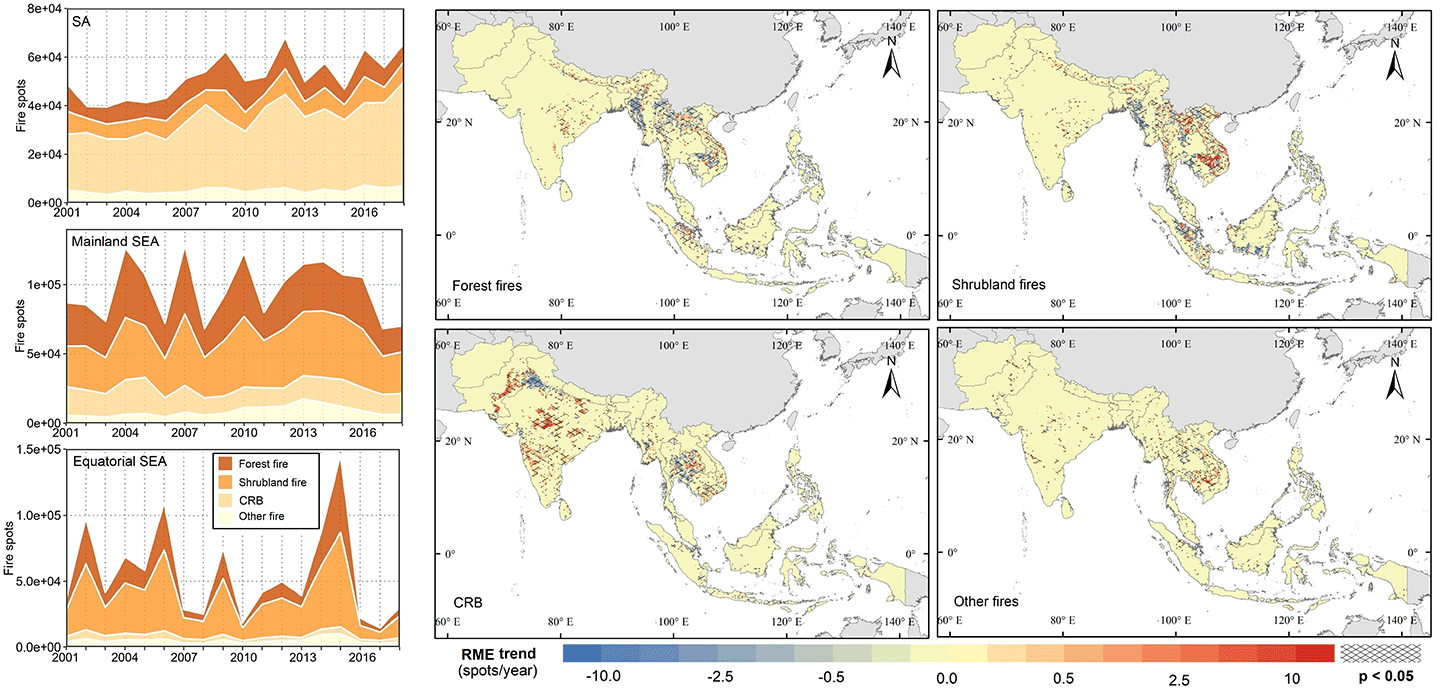Recent Research Results Biomass burning spatiotemporal variations over South and Southeast Asia
Human-initiated biomass burning (BB) is a widespread practice for deforestation, shifting cultivation, and post-harvest vegetative material removal. Massive amounts of particulate matter emissions from BB decease atmospheric visibility, causing severe haze pollution and increasing respiratory and cardiovascular morbidity, mortality, and hospital admissions. BB frequently occurs in most parts of South Asia (SA) and Southeast Asia (SEA). And because the BB characteristics in SA/SEA are inhomogeneous and cannot be monitored at the ground-level, it is essential to apply remote sensing technology to specify the spatiotemporal variations of BB.
In this study, MODIS active fire (MOD14A1) and land use products (MCD12Q1) were integrated to classify and evaluate BB*1 spatiotemporal variations over SA/SEA. Because the BB time series in equatorial SEA was too noisy, a more robust trend analysis, Siegel's repeated median estimator (RME)*2, was adopted to reduce the influence of outliers. Additionally, a monotonic trend analysis (Mann-Kendall test*3) and two geographic distribution analyses (Standard Deviation Ellipse and Median Center*4) were conducted to further quantify the interannual variations and summarize the spatial characteristics of BB. Finally, the influence of rainfall and El Niño-Southern Oscillation (ENSO) events were fully explored.
The results indicated that BB in SA was dominated by crop residue burning (CRB), which accounted for 57.30% of the annual BB spots. From 2001 to 2018, CRB in SA significantly increased by 844 spots/yr and the increase region was primarily distributed in central/southern India and eastern Pakistan (Fig). While, CRB in Punjab-Haryana, which was deemed a significant source of air pollution for the Indo-Gangetic Plain, presented a substantial declining trend (Fig). This indicates that the measures implemented by local governments effectively mitigate CRB in Punjab-Haryana; however, the increase in CRB in central/southern India and eastern Pakistan still require more attention, which is indispensable in improving the air quality in SA.
BB in equatorial SEA was extremely vulnerable to El Niño events, and when the annual SST anomalies within the Niño 3 region improved by 1℃ (5N-5S, 150W-90W), the annual number of BB spots and fire radiative power (FRP) of equatorial SEA increased by 51,800 and 2.40×106 MW, respectively. Although the interannual variation in equatorial SEA is dramatic, the RME analysis still reveals that the BB significantly declined by -1825 spots/yr. This decreasing trend reflects the Indonesian government endeavors to curb indigenous BB and restore peatland ecosystems. However, taking substantial measures to reduce anthropogenic fire sources remains imperative in preventing devastating BB during El Niño events.


